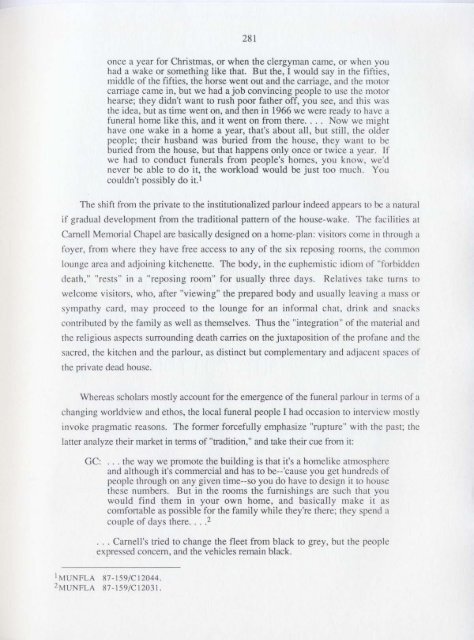Untitled - Memorial University's Digital Archives - Memorial ...
Untitled - Memorial University's Digital Archives - Memorial ...
Untitled - Memorial University's Digital Archives - Memorial ...
Create successful ePaper yourself
Turn your PDF publications into a flip-book with our unique Google optimized e-Paper software.
281<br />
once a year for Christmas, or when the clergyman came, or when you<br />
had a wake or something like that. But the, I would say in the fifties,<br />
middle of the fifties, the horse went out and the carriage, and the motor<br />
carriage came in, bUI we had a job convincing people to use the motor<br />
hearse; they didn't want to rush poor father off, you see, and Ihis was<br />
the idea, bUI as time went on. and then in 1966 we were ready to have a<br />
funeral home like this, and it went on from there. Now we might<br />
have one wake in a home a year, that's about all, bUI still, the older<br />
people; their husband was buried from the house, they want to be<br />
buried from the house. but that happens only once or twice a year. If<br />
we had to conduct funerals from people's homes. yOLl know, we'd<br />
never be able to do it, the workload would be just too much. You<br />
couldn't possibly do it. l<br />
The shift from the private to the institutionalized parlour indeed appears 10 be a natural<br />
if gradual development from the traditional pattern of the house-wake. The facilities at<br />
Carnell <strong>Memorial</strong> Chapel are basically designed on a home-plan: visitors come in through a<br />
foyer, from where they have free access to any of the six reposing rooms, the common<br />
lounge area and adjoining kitchenette. The body, in the euphemistic idiom of "forbidden<br />
death," "rests" in a "reposing room" for usually three days. Relatives take turns to<br />
welcome visitors, who, after "viewing" the prepared body and usually leaving a mass or<br />
sympathy card, may proceed to the lounge for an informal chat, drink and snacks<br />
contributed by the family as well as themselves. Thus the "integration" of the material and<br />
the religiolls aspects surrounding death carries on the juxtaposition of the profane and the<br />
sacred, the kitchen and the parlour, as distinct but complementary and adjacent spaces of<br />
the private dead house.<br />
Whereas scholars mostly account for the emergence of the funeral parlour in terms of a<br />
changing worldview and ethos, the local funeral people I had occasion to interview mostly<br />
invoke pragmatic reasons. The former forcefully emphasize "rupture" with the past; the<br />
latter analyze their market in tenns of "tradition," and take their cue from it:<br />
GC: ... the way we promote the building is that it's a homelike atmosphere<br />
and although it's commercial and has to be--'cause you get hundreds of<br />
people through on any given time--so yOlI do have to design it to house<br />
these numbers. But in the rooms the furnishings are such that yOll<br />
would find them in your own home, and basically make it as<br />
comfortable as possible for the family while they're there; they spend a<br />
couple of days there.... 2<br />
. Carnell's tried 10 change the fleet from black 10 grey, but the people<br />
expressed concern, and the vehicles remain black.<br />
lMUNFLA 87-159/CI2044.<br />
2MUNFLA R7-159/CI2031.

















